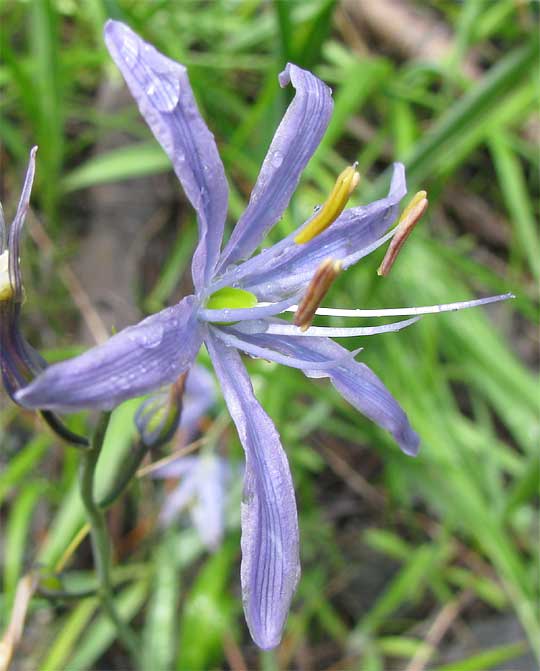Excerpts from Jim Conrad's
Naturalist Newsletter
from the May 10, 2009 Newsletter, issued from the Siskiyou Mountains west of Grants Pass, Oregon:
CAMASS LILIES GALORE
This week one of the most conspicuous flowerings -- with its blue flowers often painting broad splotches of diffuse azure blush across the green slopes -- has been the 15-inch-tall Camass, CAMASSIA LEICHTLINII, a few at a boulder's base seen below:

These members of the Lily Family arise from bulbs, so once the dry season arrives and its seeds are sown, the aboveground parts will die back and the bulbs will lie dormant through the remaining hot dry season. When you see the plant's abundance here you can't help wondering whether all those bulbs might constitute a food source.
They do. They can be eaten raw or cooked, though the raw, starchy bulb has a slightly disagreeable gummy texture. The bulbs are best when slowly baked, developing a sweetness. Cooked bulbs also have been dried and ground to make a thickener for soups, and for mixing with flour when baking bread and cakes. Indigenous Americans once boiled down large quantities of bulbs to make a molasses.

Above you can see what an elegant blossom the species produces. There you see six blue "tepals," which is what you call the segments of the "perianth," which is what you call the thing resulting with the calyx and corolla merge to form one corolla-like item. The oval, green ovary lies nested where the tepals come together and six stamens likewise arise from beneath the ovary. Rain has knocked off three of the stamens' anthers. A slender, pale, stiff, stigma-tipped style arises atop the ovary.
At first glance Camass looks a lot like the hyacinth, also in the Lily Family, so how are they different? The most obvious difference is that the hyacinth's perianth lobes unite into a cylinder surrounding and hiding the ovary, while in the picture you can see that the Camass's tepals are separate from one another all the way to their bases.